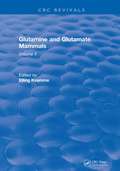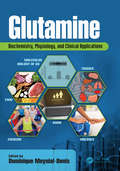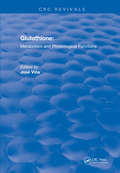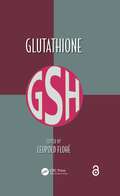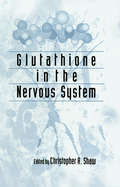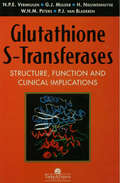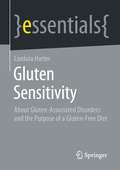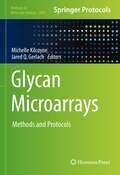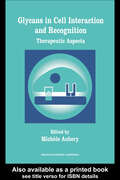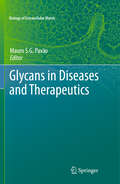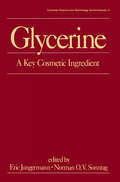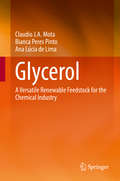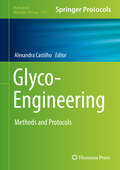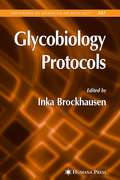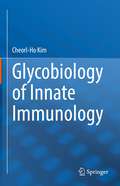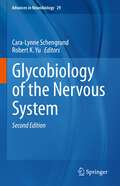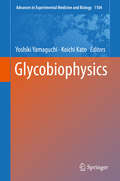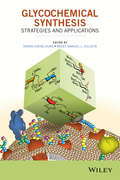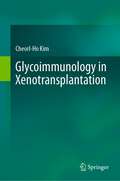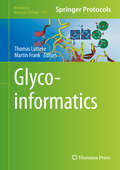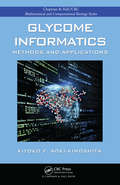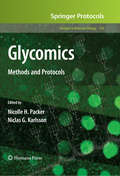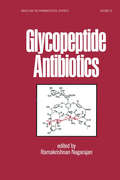- Table View
- List View
Glutamine and Glutamate Mammals: Volume II
by Elling KvammeBased on the joint effort of a great many top scientists, this book covers most aspects of the metabolism and function of glutamine and glutamate in mammals.
Glutamine: Biochemistry, Physiology, and Clinical Applications
by Dominique Meynial-DenisGlutamine: Biochemistry, Physiology, and Clinical Applications describes the different functions of glutamine (Gln) in animals and humans. Gln is both a nutrient and a signaling molecule, and its functions go beyond those of a simple metabolic fuel or protein precursor. This book has gathered together, in an unbiased and critical manner, all the available evidence and research on Gln including pathology (neurological diseases, intestinal diseases, critical illness, and cancer), physiology (successful aging), catabolic states, immunity, and exercise. Special attention is given to the potential benefit of Gln in states of insulin resistance and the role of Gln as a "conditionally essential" amino acid. The contributors are either pioneers or experts in the area of Gln from all around the globe, including Australia, Brazil, Canada, Europe, China, and the United States. This book is a valuable source of information for nutrition scientists, medical doctors, sports scientists, food scientists, dietitians, and anyone interested in nutrition. It is also a valuable resource for students in these fields and will be an important addition to university libraries.
Glutathione (CRC Press Revivals)
by Jose VinaThe aim of this important book is to present the reader with developments concerning glutathione research. This work focuses on the synthesis-degradation and oxidation-reduction cycles of glutathione, the physiological functions of glutathione (especially in mammalian cells), and the analytical methods used to accurately measure the glutathione status of cells. This resource addresses specific modification of glutathione metabolism that is of special interest in the treatment of some tumors. This rare volume also introduces some different, new techniques on how to accurately measure glutathione, specifically in its oxidized form. Anyone involved with biochemistry, physiology, toxicology, pharmacology, nutrition and radiation biology will find this publication interesting and filled with useful information. It is also a valuable reference for research scientists in such fields as aging, metabolism disorders, and glutathione research.
Glutathione (Oxidative Stress and Disease #1)
by Leopold FlohéThis is the first serious attempt to synthesize all that became known of glutathione over the last three decades. The book contains an update of glutathione biosynthesis with special emphasis on its regulation in adaptive stress responses. Other chapters review glutathione transport systems and glutathione peroxidases and their differences in substrate specificities and localization. Further contributions center on the diversified roles of different glutathione-S-transferases and the roles of nitrosoglutathione and glutaredoxins - a subfamily of redoxins. The book closes with discussions of the analogous or homologous thiol metabolism in pathogens and the potential suitability of involved enzymes as drug targets.Key selling features: Summarizing the way glutathione is involved in stress responses Compiling the multiple ways glutathione affects inflammatory responses Disclosing how glutathione dampens programmed cell death such as ferroptosis Exploring the enigma of how enzymes accelerate glutathione-dependent processes Discussing how detoxification and redox regulation is mediated by glutathionylation Reviewing the ways glutaredoxins catalyze protein disulfide reduction Highlighting the medical impact of glutathione-related metabolic pathways Illustrating the role thiol metabolism of pathogens might play in drug discovery
Glutathione In The Nervous System
by Christopher A. ShawThe goal of this text is to focus readers attention on three major areas; the origin and localization of GSH in the nervous system; the multiple effects of GSH on neural health activity; and the potential for alterations on GSH status to lead to neurological damage of the type observed in amyotrophic lateral sclerosis, Parkinson's disease and other neurological disorders. The text also touches upon the additional roles of the antoxidant GSH, including possible neurotransmitter action, redox modulation of ionotropic receptor function, and neuroprotection against exicitoxic actions of glutamate.
Glutathione S-Transferases: Structure, Function and Clinical Implications
by N. P. E. Vermeulen G. J. Mulder H. Nieuwenhuyse W. H. M. Peters P. J. VAN BLADERENGlutathione s-transferases (GSTs) constitute the most important enzymes protecting human and many other organisms from potentially toxic chemicals, including drugs and carcinogens. This book reviews scientific developments in research of this enzyme.
Gluten Sensitivity: About Gluten-Associated Disorders and the Purpose of a Gluten-Free Diet (essentials)
by Cordula HarterGluten sensitivity is a multifactorial phenomenon. In the medical context, it is associated with symptoms that occur after the consumption of gluten-containing foods. However, not all cases of perceived gluten sensitivity are medically diagnosable. Only for celiac disease and wheat allergies clear diagnostic criteria exist. In most cases patients have non-Celiac Non-Wheat Allergy Wheat Sensitivity (NCWS). Gluten can rarely be detected as a causative agent in NCWS. Rather, other ingredients of wheat, such as ATI or FODMAP, or a disturbed intestinal microbiota may be considered as triggers for the disease. Cordula Harter puts it straight: gluten sensitivity is a fashion trend that is followed by many more people than there are diagnosed patients. The author shows that gluten-containing cereals are nutritionally high-quality foods that provide valuable nutrients and fiber. Elimination is rarely medically indicated and often benefits the food industry more than the consumer. This Springer essential is a translation of the original German 1st edition essentials, Gluten-Sensitivität by Cordula Harter, published by Springer Fachmedien Wiesbaden GmbH, part of Springer Nature in 2019. The translation was done with the help of artificial intelligence (machine translation by the service DeepL.com). A subsequent human revision was done primarily in terms of content, so that the book will read stylistically differently from a conventional translation. Springer Nature works continuously to further the development of tools for the production of books and on the related technologies to support the authors.
Glutenunverträglichkeit: Über Gluten-assoziierte Erkrankungen und den Sinn einer glutenfreien Ernährung (essentials)
by Cordula HarterGlutenunverträglichkeit ist ein multifaktorielles Phänomen. Im medizinischen Kontext werden damit Symptome assoziiert, die nach dem Verzehr von glutenhaltigen Nahrungsmitteln auftreten. Jedoch sind nicht alle Fälle einer wahrgenommenen Glutenunverträglichkeit medizinisch diagnostizierbar. Nur für Zöliakie und Weizenallergien bestehen eindeutige Diagnosekriterien. In den meisten Fällen besteht eine Nicht-Zöliakie-Nicht-Weizenallergie-Weizensensitivität (NCWS). Gluten kann bei NCWS nur selten als verursachendes Agens nachgewiesen werden. Vielmehr kommen andere Inhaltsstoffe von Weizen, wie ATI oder FODMAP, oder eine gestörte intestinale Mikrobiota als Krankheitsauslöser in Frage. Cordula Harter stellt klar: Glutenunverträglichkeit ist ein Modetrend, dem viel mehr Menschen folgen, als es diagnostizierte Patienten gibt. Die Autorin zeigt, dass glutenhaltige Getreide ernährungsphysiologisch hochwertige Nahrungsmittel sind, die wertvolle Nährstoffe und Ballaststoffe liefern. Eine Eliminierung ist nur selten medizinisch indiziert und nutzt der Nahrungsmittelindustrie oft mehr als dem Verbraucher.Die Autorin:Dr. Cordula Harter ist Privatdozentin und Lehrkoordinatorin am Biochemie-Zentrum der Universität Heidelberg.
Glycan Microarrays: Methods and Protocols (Methods in Molecular Biology #2460)
by Michelle Kilcoyne Jared Q. GerlachThis volume encompasses short targeted reviews and methods featuring the construction and use of glycan microarray platforms. Chapters guider readers through glycan microarrays comprised of synthetic glycans, natural biomolecules, bacteria, neoglycoproteins, various applications and progress of these platforms. Written in the format of the highly successful Methods in Molecular Biology series, each chapter includes an introduction to the topic, lists necessary materials and reagents, includes tips on troubleshooting and known pitfalls, and step-by-step, readily reproducible protocols. Authoritative and cutting-edge, Glycan Microarrays: Methods and Protocols aims to highlight the interdisciplinary nature of the development and use of the glycan microarray platform.
Glycans in Cell Interaction and Recognition
by Matthew J. Sottile Timothy G. Mattson Craig E. RasmussenGlycoproteins play an important role in the regulation of gene expression, cell growth, migration, differentiation and apoptosis. Over the last decade, research has highlighted the therapeutic implications of glycoproteins for many physiological and pathological processes, such as inflammation, arthritis and metastasis. The first part of the book d
Glycans in Diseases and Therapeutics
by Mauro S.G. PavãoInitially believed to be inactive molecules, glycans are now considered essential for life, both under normal and pathological conditions. This volume of the series "Biology of Extracellular Matrix" reviews the most recent findings on the role of glycans in the development of diseases and the possible therapeutic use of this class of molecules. It shows how the interaction of glycans with growth factors, growth factor binding proteins, extracellular proteases, protease inhibitors, chemokines, morphogens, and adhesive proteins regulates inflammation, infection, cancer, atherosclerosis, thrombosis and embryonic stem cell biology. Furthermore, an extensive survey about the structure and pharmacological effects of unique marine glycosaminoglycans is discussed as well as the possibility of using these glycans as therapeutic agents.
Glycerine: A Key Cosmetic Ingredient
by Eric Jungermann Norman O.V. SonntagThis book comprehensively covers the chemical and physical properties and manufacturing and handling procedures of glycerine and the use of this material in cosmetic and personal care products and in other industrial areas such as testing laboratories and manufacturing and marketing sectors.
Glycerol
by Claudio J. A. Mota Bianca Peres Pinto Ana Lúcia de LimaThis book is aimed at providing a concise discussion on the use of glycerol as a renewable raw material for the chemical industry. With the increasing use of biodiesel produced from oils and fats, there is a surplus of glycerol in the world. This abundant and rather cheap raw material can be transformed in commodities and specialty chemicals, as well as in fuels. The book describes the main processes of chemical transformation of glycerol, highlighting those that are currently in commercial use and pointing out potential processes to be used in the future. The first chapter introduces the concept of biofuel and briefly describes the production of biodiesel. It also highlights glycerol as the main byproduct of biodiesel synthesis and presents some numbers regarding the world production of glycerol. The second chapter shows the common uses of glycerol and addresses the point whether or not they can drain the large amounts of glycerol produced from biodiesel. The chapter addresses pros and cons of each use. The third chapter covers the main biotechnological processes of glycerol transformation. The fourth chapter thoroughly describes the main thermochemical processes to transform glycerol into commodities, products that will be further used in the chemical industry to produce polymers, for instance. The fifth chapter covers the production of glycerol derivatives of high added-value. The sixth chapter addresses the use of glycerol in the context of a biorefinery. The main idea is to show that many of the processes described in the previous chapters could be entirely green, using exclusively renewable raw materials.
Glyco-Engineering
by Alexandra CastilhoConceived with the intention of providing an array of strategies and technologies currently in use for glyco-engineering distinct living organisms, this book contains a wide range of methods being developed to control the composition of carbohydrates and the properties of proteins through manipulations on the production host rather than in the protein itself. The first five sections deal with host-specific glyco-engineering and contain chapters that provide protocols for modifications of the glycosylation pathway in bacteria, yeast, insect, plants and mammalian cells, while the last two sections explore alternative approaches to host glyco-engineering and selected protocols for the analysis of the N-glycans and glyco-profiling by mass spectrometry. Written for the highly successful Methods in Molecular Biology series, chapters include introductions to their respective topics, lists of the necessary materials and reagents, step-by-step, readily reproducible laboratory protocols and tips on troubleshooting and avoiding known pitfalls. Authoritative and extensive, Glyco-Engineering: Methods and Protocols offers vast options to help researchers to choose the expression system and approach that best suits their intended protein research or applications.
Glycoanalysis Protocols
by Elizabeth F. HounsellGlycoanalysis Protocols, 2nd ed., makes available to all protein scientists, and particularly those working in today's pharmaceuticals industry, the most advanced and reproducible glycoanalysis techniques. These detailed, up-to-date, and proven analytical methods cover the areas of glycoprotein macromolecular structural analysis, oligosaccharide profiling, lipid conjugate characterization, microorganism structure determination, and proteoglycan function. They also include advanced analytical techniques in biotechnology during the production of recombinant glycoproteins and other therapeutics. These protocols will well serve anyone starting work on the analysis of glycoproteins, as well as experienced investigators seeking to carry their expertise to higher levels of accomplishment.
Glycobiology Protocols
by Inka BrockhausenA distinguished panel of international experts reviews the importance of glycobiology, an interdisciplinary field encompassing chemistry, biochemistry, biology, physiology, and pathology. Glycobiology Protocols highlights important methodological progress that has been made in the field of glycobiology, helping scientists to answer specific questions on glycoprotein structures, on the biosynthesis of glycoconjugates, and on the functions of lipid- or protein-bound carbohydrates. Glycobiology Protocols contains specific methods for the analysis of the structures or functions of glycoconjugates, as well as of glycosyltransferases and glycosidases involved in the biosynthesis of glycans. The methods described for specific systems can be modified for investigations of similar biomolecules and tissues or cell types. Comprehensive and highly practical, Glycobiology Protocols provides researchers with a solid basis for studying the many aspects of glycobiology with state-of-the-art methods. The protocols follow the successful Methods in Molecular BiologyTM series format, with each one offering step-by-step laboratory instructions, an introduction outlining the principle behind the technique, lists of equipment and reagents, and tips on troubleshooting and avoiding known pitfalls.
Glycobiology of Innate Immunology
by Cheorl-Ho KimThis book presents the latest knowledge and the most recent research results on glycobiology of innate immunology. Innate immunity is the crucial part of the immunological defense system that exerts their distinct functions through binding to certain functional glycoproteins. They play a role in various human diseases and also function against microbial invaders and self-associated molecular patterns. Co-regulated expression of glycan-binding is associated with many biological components such as cellular oncotransformation, phenotype change, neuronal or embryonic development, regulation of cell division, cell–cell interaction, cell attachment, adhesion, and motility, and intracellular signaling via protein–carbohydrate or carbohydrate–carbohydrate interactions.This book opens by providing the key background on glycans in innate immunity and its mechanisms behind the Dendritic cell interactions during infection and inflammation are examined in depth, and the concluding chapter is devoted to signaling tumor immunotherapy. Up-to-date information is then presented on all aspects of glycan structure-recognizing signaling. The book should assist in the further development of new strategies against emerging infectious agents and intractable diseases.
Glycobiology of the Nervous System (Advances in Neurobiology #29)
by Robert K. Yu Cara-Lynne SchengrundThis new edition provides comprehensive coverage of the variety and complexity of the roles that glycoconjugates play in the cells of the nervous system. Basic fundamental principles as well as the latest developments in neural glycobiology are discussed. Topics covered range from the structure and metabolism of the saccharide chains and current approaches used in their study, to changes glycoconjugates undergo during development and aging of the nervous system and the roles they have in neurological disease. New topics include a detailed discussion of cells found within the nervous system, an extensive listing of congenital disorders of glycosylation of both proteins and lipids, the roles of glycans in neuronal axon growth/guidance and voltage-gated channels, the role of intra-lysosomal luminal vesicles in lysosomal storage disorders, and, in the time of the COVID-19 pandemic, the role of carbohydrates in infection by SARS-CoV-2. The breadth and depth of topics covered make this an essential reference for those new to the field as well as for more experienced investigators.
Glycobiophysics (Advances in Experimental Medicine and Biology #1104)
by Yoshiki Yamaguchi Koichi KatoThis book presents state of the art biophysical approaches to issues in glycobiology that have cutting-edge applications. Despite the importance of glycosylation, the complexity, heterogeneity, and flexibility of the glycans have inhibited their study. Each chapter in this book explains very recent significant advances in biophysical approaches through the use of techniques such as NMR spectroscopy, mass spectrometry, single-molecule imaging, X-ray crystallography, high-speed atomic force microscopy, and computational simulation and their integrative application. Concrete examples are provided of the value of these techniques in addressing key problems in the field. In addition, significant functional glycobiological issues are considered. For example, glycolipids can form dynamic clusters on cell membranes and provide platforms for molecules involved in cell recognition and subsequent signal transduction. The detailed delineation of these molecular systems is discussed, revealing their structural complexity and ability to assemble transiently. This timely book will be of value for graduate students and postdocs interested in frontier topics in glycoscience and also for senior bio-researchers in academic and industrial fields.
Glycochemical Synthesis: Strategies and Applications
by Shang Cheng Hung Medel Manuel L. ZuluetaThis book is a comprehensive and concise review on principles, strategies, and crucial advances in glycochemistry. It focuses on synthesis and practical applications and emphasizes state-of-the-art approaches to the assembly and design of sugars.• Provides detailed discussion on specific topics like oligosaccharide assembly and design of sugars, techniques in glycoconjugate preparation, multivalency, and carbohydrate-based drug design• Uses notable examples, like solution-based one-pot methods and automated methods for sugar assembly, to illustrate important concepts and advances in a rapidly emerging field• Discusses practical applications of carbohydrates, like medicine, therapeutics, drug and vaccine development
Glycoimmunology in Xenotransplantation
by Cheorl-Ho KimThis book describes general glycobiology in emphasizing the structures, biosynthesis, glycosylation and distribution of the glycans and xenogenic glycoantigens in eukaryotic cells of mammals including mouse, swine, chimpanzee and human. In the middle, I have focused on topics in xenotransplantation glycobiology and expand descriptions of allogenic and xenoantigenic transplantation to open the dawn in insights into the origin of life. One of the biological diversity, named species diversity, is a phenomenon environmentally adapted from the evolutionary process for long period. The distinct structures of glycans discriminate each organism and are the essential molecular basis of the discrimination and difference between the organisms, giving an incompatibility between the different species. Diversity and variations in carbohydrate chain structures between family, species, kingdoms and domains mark the global pattern and signs of immune self- and non-self recognition. In human, diversity in ABH blood group antigens is observed in human family and this type pattern distinguishes individuals from a pan-family to non-dividable unit of the family. Blood transfusion and organ transplantation are impossible even in the allogenic cross between humans if carbohydrates are ignored. This explains how and how human beings are a lonely existence. ABH-related antibodies induce hemolysis or hyperacute or allograft rejection due to incompatible graft property even between the same species. The incompatibility is an immunologic rejection when the recipient host receives the tissues or organs from the different species of donors, as well-known in pig-to-human xenotransplantation. The immunologic incompatibility between the donor pigs and the recipient human are based on the evolutionary distance between pigs and humans. This distance allows a xenograft rejection between the 2 mammals. Modification or deletion of the specific gene locus for immune rejection on genome of donor animals disrupts the immunological recognition ligands of the donor organs, consequently preventing the immune rejection of the human recipient and xenograft rejection. This book helps undergraduate and graduate students, researcher and professors who are involved in the glycobiology and xenoantigenic biology with recent advances in the xenotransplantation basic and clinic.
Glycoinformatics
by Thomas Lütteke Martin FrankThis book provides current glycoinformatics methods and protocols used to support the determination of carbohydrate structures in biological samples as well as carbohydrate structure databases, the interaction of carbohydrates with proteins, and theoretical and experimental methods to study their three-dimensional structure and dynamics. Glycoinformatics explores this recently emerged field, which has come into being in order to address the needs of encoding, storing, and analyzing carbohydrate 'sequences' and their taxonomy using computers. Written in the highly successful Methods in Molecular Biology series format, chapters contain the kind of detailed description and key implementation advice to ensure successful results. Authoritative and timely, Glycoinformatics demonstrates the progress that has been achieved in glycoinformatics, which indicates that it is no longer a niche subject covered by only a few scientists but is truly coming of age.
Glycome Informatics: Methods and Applications (Chapman And Hall/crc Computational Biology Ser.)
by Kiyoko F. Aoki-KinoshitaA Focused, State-of-the-Art Overview of This Evolving FieldPresents Various Techniques for GlycoinformaticsThe development and use of informatics tools and databases for glycobiology and glycomics research have increased considerably in recent years. In addition to accumulating well-structured glyco-related data, researchers have now developed semi
Glycomics
by Nicolle H. Packer Niclas G. KarlssonDue to the significant contributions of carbohydrates to the functional diversity of the cell, the challenging study of the glycome has expanded beyond the research of carbohydrate experts and into the wider scope of the life sciences. To aid all scientists now delving into this vital subject area, Glycomics: Methods and Protocols collects a compendium of detailed laboratory protocols reflecting the increasing availability of sample preparation, chromatographic, electrophoretic, mass spectrometric, and bioinformatic tools specifically designed for the analysis of glycosylation. Leading researchers in the field address subjects such as glycoprotein and proteoglycan analysis, glycosylation structure determination, as well as various approaches to investigate the interaction between glycans and a variety of carbohydrate-recognizing proteins in order to aid exploration into the functional significance of the oligosaccharides. Written in the highly successful Methods in Molecular BiologyTM series format, the chapters include introductions to their respective topics, lists of the necessary materials and reagents, step-by-step, readily reproducible protocols, and notes on troubleshooting and avoiding known pitfalls. Authoritative and cutting-edge, Glycomics: Methods and Protocols serves as a valuable guide for experimenters facing the challenges of glycan analysis in hope of providing further insights into the biology of cell-cell communication and interaction.
Glycopeptide Antibiotics
by Ramakrishnan NagarajanThis work describes all known assays used to discover new glycopeptide antibiotics. It discusses practical techniques for screening, isolating and analyzing glycopeptide antibiotics, correlating structure-activity relationships with the mode of action. Every relevant chemical aspect of the carbohydrate components of glycopeptide antibodies is examined.
